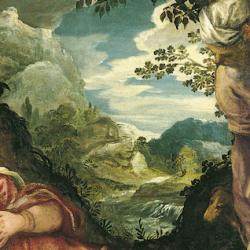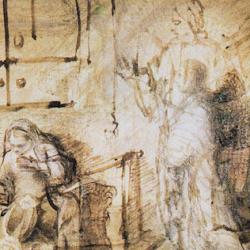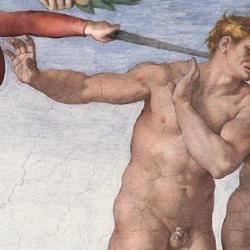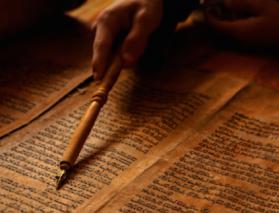On the second day of creation, Yahweh divided waters, putting some waters above and some waters below. In between those divided waters, the Lord put the firmament, and he called that firmament “heaven.” At the end of Day 2, there were two heavens: In addition to the highest heaven in which the Lord Himself was enthroned, there was a second heaven, a heaven visible from earth, the blue dome of the sky.
Later, on Day 4 of creation, the Lord filled the firmament with sun, moon, and stars. From earth, the firmament appears to be a rounded surface, but from Day 4 we know that the firmament has depth. It is like the antechamber of heaven, the first room of the heavens. It is what we call outer space.
And the Lord put these lights in the firmament for several purposes. They were to “separate the day and night” (1:14). They governed day and night, the sun to “govern” the day and the moon to “govern” the night (1:16). The sun and moon existed to “divide” light and dark and “govern” and night.
These two functions of the lights of the firmament carry out the work of Yahweh Himself. He originally divided light and darkness and assigned them the names day and night; and on the first three days, Yahweh Himself controls the beginning and ending of lighttime and dark. He governs day and night directly. In the middle of the creation week, however, Yahweh gives over His authority to creatures. Dividing and governing day and night are divine works, exercise of divine authority. The sun is the governor of the day, and the moon of the night.
This is not the first time God gave His creation some of His divine power. On Day 3 of the creation week, He divides the waters below the firmament, water from water, so that dry land appears. For the first time in the creation account, Yahweh instructs something in creation to do something, and for the first time He tells something in creation to be fruitful. He speaks to the earth and tells the earth to sprout with plants yielding seed and trees bearing fruit. He doesn’t tell trees and plants to come into existence directly, as He did the sun and moon or the firmament. The power to produce fruitful plants and trees is given to the earth.
We have here the general point that God delegates His creativity and authority to the creation. He doesn’t hold all creative power in Himself. His creative Lordship is evident in the fact that He gives creative authority. Yahweh is so much the Creator and Lord that His absolute position is not threatened by giving creative lordship to creation.
Beyond that general principle, we are told something here about human beings. Human beings are made of the dust of the ground, and are called to be fruitful and multiple. That piece of animated dust, Adam, is placed in a garden and told to dress and keep it, to make it fruitful. Day 3 anticipates this reality. In delegating creative authority to the land that He calls earth, the Lord is anticipating what He will do with man. Man will be drawn from the dust, given life, and then become fruitful and multiply and fill the earth.
On Day 3, Yahweh delegates creative power, fruitfulness, to the creation. He does the same on Day 4, giving the sun and moon the power to do what He does – to divide and govern. And the same is true of a third function of the sun, moon, and stars, namely, their function as time-keepers.
Before Day 4, Yahweh was the direct governor of time. He made it light and ended the light. He started days and faded at the end of days. On Day 4, however, Yahweh delegates authority over days and times to the heavenly lights; they become the clocks of creation. They are set in the heavens not only for “signs” or symbols, but also to mark seasons, days, and years. Days and years are obvious: The rising and setting of the sun mark the limits of a day, and the revolution of the earth around the sun marks the limits of the year.
The word for “seasons” is mo’ed , and refers to an “appointed time.” That word is picked up in the Mosaic covenant to describe Israel’s festivals times. It’s the usual word for “feast” in the Hebrew Old Testament (Leviticus 23:2-4), and from this it becomes the word also for an assembly that takes place at an appointed time. The tabernacle is sometimes called the “tent of mo’ed ,” and that means it is the place where Israel keeps the appointments that God sets for Israel.
Yahweh sets these times and appointments, and because the Lord sets the appointments, Israel is required to show up. When He institutes the Passover and feast of unleavened bread as a regular feast day, He sets an “appointed time” that Israel is supposed to keep (Exodus 13:10), and when He reiterates this in Exodus 23, He repeats that these are appointments that Yahweh Himself set.
Yet, here in Genesis we learn that these appointed times, this arrangement of feasts and seasons, is delegated to creatures. Yahweh doesn’t intervene every year to tell Israel to keep Passover. They keep that appointment because their clock – the moon – tells them to.
Everything in the Old Testament calendar is specifically pegged to the moon. The first appearance of the sliver of moon after a new moon marked the beginning of a month, and each month Israel celebrated a new moon festival. After the first appearance of the moon in the month of Abib, they counted fourteen days and on that day, when the moon was full, they slaughtered their Passover lambs or goats. Pentecost was tied to the Feast of Unleavened bread which was associated with Passover, and the feast of booths that ended the year likewise took place in the full moon.
So, the Lord makes appointed times with His people, but He leaves to creatures –
the sun and moon – the government and marking of these appointed times. He is the one who governs day and night, and divides the one from the other, but He governs and divides through the created lights, sun and moon.
But the pattern we say in Day 3 applies also to Day 4. On Day 3, Yahweh delegated the power to produce plants and trees, to produce fruit, to the earth, and this symbolized the eventual delegation of authority to produce fruit and seed to Adam and His seed, to human beings made of dust. So also, Day 4 gives authority over day and night, light and dark, to heavenly lights. But this is ultimately a symbol of what Yahweh will do with human beings. Human beings mark time by sun and moon, and in the Old Covenant especially by the moon. But we are created to eventually be elevated to that position, to become the time-keepers for creation.
With the coming of the new covenant, this sequence of night and day stays in place, but also shifts in radical ways. Obviously, we still have a cycle of day and night; the sun is still there, and the moon is still there. The Lord still keeps appointed times with His people, and practically speaking these times are related to the cycles of these heavenly clocks. Any time-keeping we do should acknowledge the reality of these lights. We don’t yet live in the age to come, when the alternation of light and dark ends and we enter into eternal daylight.
Yet prophecies of the coming of the new covenant frequently speak of the blotting out of the sun and moon. This is often related to the end of governors and rulers in a particular geo-political situation. When Babylon falls, the sun and moon and stars in the Babylonian political heavens goes out and falls to the ground. But the blotting out of the heavenly lights is also a sign of a change of time. The time of Babylon is coming to an end, and this is symbolized by the blotting out of the time-keeping sun and moon, and the fall of the stars.
But this is not just about the end of one or another political order. This imagery is used at times of the end of the entire Old Covenant order, which is governed by the heavenly bodies, particularly the moon. When the Lord pours out His Spirit on all mankind, the “sun will be turned to darkness and the moon to blood,” says Joel. And describing the collapse of the Old Covenant order in AD 70, Jesus says that the “sun will be darkened and the moon will not give its light, and the stars will fall from the sky” (Matthew 24:29).
With the coming of the new covenant, the old time keepers are overthrown, and somehow a new governors of time, new dividers of day and night, new clocks come into being. But what is the new clock? What replaces the sun and moon and stars as signs, governors, and keepers of time?
The New Testament’s answer is: Jesus, and in Jesus, us. In the original creation, Yahweh delegated the government of days and nights to the sun and the moon. But now, He gives the authority to govern the day and night to the sun of righteousness, Jesus, the bright morning star.
Beyond that, though, He gives that authority to human beings. We are the children of Abraham, and that means we are stars in the heavens – that’s how Abram was taught to consider his “seed.” Jesus is exalted into the heavenly places, Paul says in Ephesians, and in the next breath he says that we’re also in the heavenly places in Christ Jesus. Jesus has ascended to the right hand of the Father, and He takes us there with Him. This means many things, but one of the things it means is that we now have authority to divide light and darkness and to govern the day and night.
In fact, that’s what human beings have been doing over the two millennia since the coming of Jesus. Here in Idaho, we can almost imagine what it was like for premodern people to encounter night. When we first moved here, I remember being unnerved by how dark the nights were. I had lived around cities where the sky was never totally dark, but now I was living in a place where I can often see the Milky Way stretching across the sky from my driveway; and the fact that coyotes were howling in the blackness didn’t help. Many people today no longer live in this kind of night. They live in cities where it is never entirely dark, and even when they live in the country they have electric lights, or even the glow of a distant city.
Of course, this is not always done wisely or well. Sometimes human beings have divided darkness and light, ruled time, without regard to the lessons learned from our childhood in the Old Covenant. Sun and moon are still there, and still guides to our days and nights. We do have authority, but that authority should be exercised with wisdom.
But my point is that with the coming of the new covenant, with the incarnation, life, death, resurrection, and exaltation of the Son, we too are exalted to the heavenly places. We are given authority to set times and seasons, to divided dark and light. In the Old Covenant, Yahweh delegated the schedule of keeping appointed times to the moon. Now He delegates that same divine authority to human beings, and especially to the human beings, who are called to divide time wisely, to set appointed times. Within the church, practically, the heavenly rulers are the elders and pastors of the churches, who are given authority by Jesus to set appointed times, just as sun and moon set appointed times in the Old Covenant.











